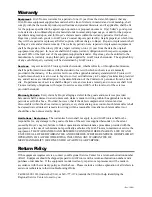
Pub. 42004-178D
Model 263 Isolation Barrier Unit (IBU)
Page: 3 of 13
\\s_eng\gtcproddocs\standard ioms - current release\42004 instr. manuals\42004-178d.doc
03/06
Wiring Requirements
Design Limits
In order to be
intrinsically safe
, energy and energy storage must be constrained to “safe” levels in
hazardous area apparatus. Wiring inherently has capacitance formed by a dielectric material between two
conductors. A buildup of this capacitance can form a surge of electricity, a dangerous situation in a
hazardous area.
Intrinsically-safe telephones require cabling that will limit the amount of capacitance formed. The
limitation on cable length was set by Underwriter’s Laboratory (UL) based on test results. This “worst
case” cable available was found to have a capacitance of 60 picofarads/foot. Therefore, UL set the cable
limitation at one mile, the length at which this worst-case cable capacitance level was still within
acceptable bounds. Cable types with less capacitance have been specified to allow connection distances
over one mile.
For example: GAI-Tronics Model 60059-001 and 60021-301 cables allow connection distances of up to
1.5 miles.
Shielded Cable
Where multiple I.S. telephone wires are routed together, shielded cable should be used. The use of
shielded cable prevents cross-talk from occurring between multiple I.S. telephone circuits. The shield
must be grounded to an I.S. ground and connected only at the IBU.
Wiring Guidelines/Control Drawing
The Model 263 provides an intrinsically-safe circuit when installed in accordance with GAI-Tronics Pub.
42004-380, Control Drawing 73242. In addition, the NEC and the CEC provide additional installation
details that are recommended for safe installation.
General Wire Types
24 AWG
22 AWG
20 AWG
19 AWG
18 AWG
Maximum capacitance,
C (picofarads/mile)
316,800 pF/mile
Maximum resistance,
R (ohms/mile)
271 171 107 85 67
*Ring signal loss,
decibels (dB/mile)
-16
-12 -8 -6 -4
*Nominal ring signal is 98 dB @ 10 feet.
































